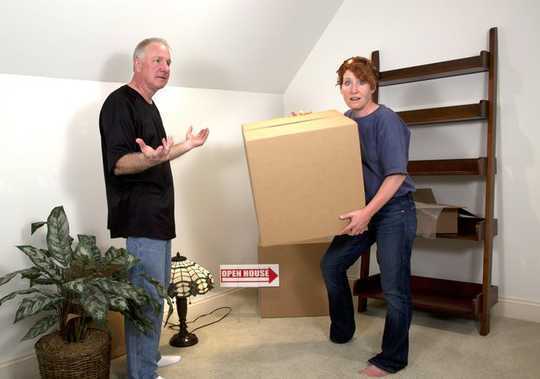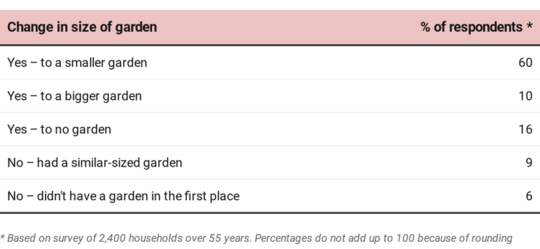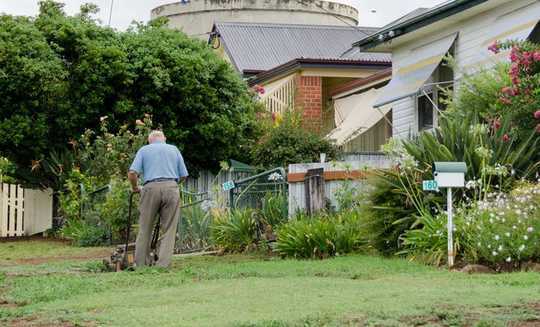 karenfoleyphotography/Shutterstock
karenfoleyphotography/Shutterstock
More than half of Australians over the age of 55 are open to downsizing, according to a new report based on a survey of 2,400 households. The main barrier to moving to a smaller home is a lack of housing that matches their needs and preferences. The rapid growth in the number of older Australians adds to the major challenge housing markets face in meeting their diverse housing needs.
Downsizing, or rightsizing, is considered an essential component of meeting the housing aspirations of older Australians. At the same time, downsizing creates housing opportunities for younger households by freeing up family homes.
The ageing population also creates fiscal challenges for government, in terms of delivering services to the home and providing residential care. Downsizing can enable older Australians to age well and age in place rather than potentially move prematurely into residential care.
The report released today by the Australian Housing and Urban Research Institute (AHURI), for which 2,400 households over 55 were surveyed, found 26% of such households had downsized. Another third had thought about it. Overall, the findings point to a strong appetite among older Australians to downsize their dwellings.
With about 6.5 million Australians aged 55 or older, living in about 4.3 million households, our findings suggest downsizing could be relevant to 2.5 million households.
Why downsize? And what are the obstacles?
We know older Australians downsize in response to life events such as changes in health and relationship status, or children leaving the parental home. Lifestyle preferences and difficulties maintaining their garden or house also shape downsizing behaviour.
Barriers to downsizing include a lack of suitable housing and a lack of financial incentives. There are also emotional and physical barriers to moving. Financial factors, however, do not greatly impact the decision to move, nor does perceived financial well-being increase once they have downsized.
Where those who had downsized were dissatisfied, this was most commonly related to the new dwelling, particularly its size, and the neighbourhood.
Is it actually downsizing?
One of the policy rationales for downsizing is to reduce the underutilisation of dwellings. However, this is at odds with the attitude of many older Australians. They consider “spare” bedrooms necessary for use as permanent guest rooms (58%), studies (50%), or dedicated rooms for children or grandchildren (31%).
Space remains important to Australian downsizers. Over half of them move to a dwelling with three or more bedrooms. A third move to an apartment.
However, two-thirds of downsizers surveyed did move to a dwelling with fewer bedrooms. Three bedrooms was the preferred dwelling size for older Australians. Downsizing the garden was essential for most.

 Author provided
Author provided
Older Australians aspire to attain or retain home ownership. Their preferred neighbourhood has shopping, medical, recreational and public transport services all within walking distance.
Downsizers appear mobile. While under a quarter downsized within their original neighbourhood, 42% moved to a neighbourhood completely new to them.
The survey finding of a lack of suitable housing options matching would-be downsizers’ preferences may explain why so few were able to downsize in their original neighbourhood.
Delivering what older Australians want
If the local market does not have enough options available to meet the needs of older households, it is very difficult to downsize within an existing community. Moving to another desired location can also be problematic.
Meeting the needs of older Australians generally means an increase in medium-density housing. Developers are likely to require incentives to produce these medium-density products rather than potentially more profitable high-density development – although there is, of course, a downsizing market for well-located apartments.
 Most downsizers want less garden to maintain, but still want a three-bedroom home. Ben Romalis/Shutterstock
Most downsizers want less garden to maintain, but still want a three-bedroom home. Ben Romalis/Shutterstock
The retirement industry has begun responding to the aspirations of older Australians. It is developing larger dwellings and offering a growing range of options, from high-end to affordable — all of which are accessible and suitable for ageing in place.
Equity-rich older Australians may wish to build a new dwelling in which to downsize. But they are often unable to borrow for this unless they have considerable capital available.
To support this avenue, new development finance models could be created to allow older Australians to develop without first having to sell the primary home. This shift would allow more collaborative forms of development, such as a group of like-minded individuals developing a site as housing for a small community.
For those vulnerable private renters moving into retirement, more secure rental accommodation through the social housing sector and delivered privately is essential. The community housing sector has a key role to play.
Where next?
The Australian housing landscape must shift towards a model of dwelling diversity with secure tenures – ownership and rental – in neighbourhoods where residents can walk easily to weekly services and recreation facilities, participate socially and be close to public transport options.
Design is equally important. Australians need adaptable dwellings that can change to meet housing needs.
Such a landscape will provide effective downsizing options in which households can age well in the places that best meet their needs and aspirations.
About The Authors
Amity James, Senior Lecturer, School of Economics, Finance and Property, Curtin University; Steven Rowley, Head of School, Economics, Finance and Property, Curtin University. Director, Australian Housing and Urban Research Institute, Curtin Research Centre, Curtin University, and Wendy Stone, Associate Professor, Centre for Urban Transitions and Director, Australian Housing and Urban Research Institute Swinburne Research Centre, Swinburne University of Technology
This article is republished from The Conversation under a Creative Commons license. Read the original article.
Recommended books:
Capital in the Twenty-First Century
by Thomas Piketty. (Translated by Arthur Goldhammer)
 In Capital in the Twenty-First Century, Thomas Piketty analyzes a unique collection of data from twenty countries, ranging as far back as the eighteenth century, to uncover key economic and social patterns. But economic trends are not acts of God. Political action has curbed dangerous inequalities in the past, says Thomas Piketty, and may do so again. A work of extraordinary ambition, originality, and rigor, Capital in the Twenty-First Century reorients our understanding of economic history and confronts us with sobering lessons for today. His findings will transform debate and set the agenda for the next generation of thought about wealth and inequality.
In Capital in the Twenty-First Century, Thomas Piketty analyzes a unique collection of data from twenty countries, ranging as far back as the eighteenth century, to uncover key economic and social patterns. But economic trends are not acts of God. Political action has curbed dangerous inequalities in the past, says Thomas Piketty, and may do so again. A work of extraordinary ambition, originality, and rigor, Capital in the Twenty-First Century reorients our understanding of economic history and confronts us with sobering lessons for today. His findings will transform debate and set the agenda for the next generation of thought about wealth and inequality.
Click here for more info and/or to order this book on Amazon.
Nature's Fortune: How Business and Society Thrive by Investing in Nature
by Mark R. Tercek and Jonathan S. Adams.
 What is nature worth? The answer to this question—which traditionally has been framed in environmental terms—is revolutionizing the way we do business. In Nature’s Fortune, Mark Tercek, CEO of The Nature Conservancy and former investment banker, and science writer Jonathan Adams argue that nature is not only the foundation of human well-being, but also the smartest commercial investment any business or government can make. The forests, floodplains, and oyster reefs often seen simply as raw materials or as obstacles to be cleared in the name of progress are, in fact as important to our future prosperity as technology or law or business innovation. Nature’s Fortune offers an essential guide to the world’s economic—and environmental—well-being.
What is nature worth? The answer to this question—which traditionally has been framed in environmental terms—is revolutionizing the way we do business. In Nature’s Fortune, Mark Tercek, CEO of The Nature Conservancy and former investment banker, and science writer Jonathan Adams argue that nature is not only the foundation of human well-being, but also the smartest commercial investment any business or government can make. The forests, floodplains, and oyster reefs often seen simply as raw materials or as obstacles to be cleared in the name of progress are, in fact as important to our future prosperity as technology or law or business innovation. Nature’s Fortune offers an essential guide to the world’s economic—and environmental—well-being.
Click here for more info and/or to order this book on Amazon.
Beyond Outrage: What has gone wrong with our economy and our democracy, and how to fix it -- by Robert B. Reich
 In this timely book, Robert B. Reich argues that nothing good happens in Washington unless citizens are energized and organized to make sure Washington acts in the public good. The first step is to see the big picture. Beyond Outrage connects the dots, showing why the increasing share of income and wealth going to the top has hobbled jobs and growth for everyone else, undermining our democracy; caused Americans to become increasingly cynical about public life; and turned many Americans against one another. He also explains why the proposals of the “regressive right” are dead wrong and provides a clear roadmap of what must be done instead. Here’s a plan for action for everyone who cares about the future of America.
In this timely book, Robert B. Reich argues that nothing good happens in Washington unless citizens are energized and organized to make sure Washington acts in the public good. The first step is to see the big picture. Beyond Outrage connects the dots, showing why the increasing share of income and wealth going to the top has hobbled jobs and growth for everyone else, undermining our democracy; caused Americans to become increasingly cynical about public life; and turned many Americans against one another. He also explains why the proposals of the “regressive right” are dead wrong and provides a clear roadmap of what must be done instead. Here’s a plan for action for everyone who cares about the future of America.
Click here for more info or to order this book on Amazon.
This Changes Everything: Occupy Wall Street and the 99% Movement
by Sarah van Gelder and staff of YES! Magazine.
 This Changes Everything shows how the Occupy movement is shifting the way people view themselves and the world, the kind of society they believe is possible, and their own involvement in creating a society that works for the 99% rather than just the 1%. Attempts to pigeonhole this decentralized, fast-evolving movement have led to confusion and misperception. In this volume, the editors of YES! Magazine bring together voices from inside and outside the protests to convey the issues, possibilities, and personalities associated with the Occupy Wall Street movement. This book features contributions from Naomi Klein, David Korten, Rebecca Solnit, Ralph Nader, and others, as well as Occupy activists who were there from the beginning.
This Changes Everything shows how the Occupy movement is shifting the way people view themselves and the world, the kind of society they believe is possible, and their own involvement in creating a society that works for the 99% rather than just the 1%. Attempts to pigeonhole this decentralized, fast-evolving movement have led to confusion and misperception. In this volume, the editors of YES! Magazine bring together voices from inside and outside the protests to convey the issues, possibilities, and personalities associated with the Occupy Wall Street movement. This book features contributions from Naomi Klein, David Korten, Rebecca Solnit, Ralph Nader, and others, as well as Occupy activists who were there from the beginning.
Click here for more info and/or to order this book on Amazon.























